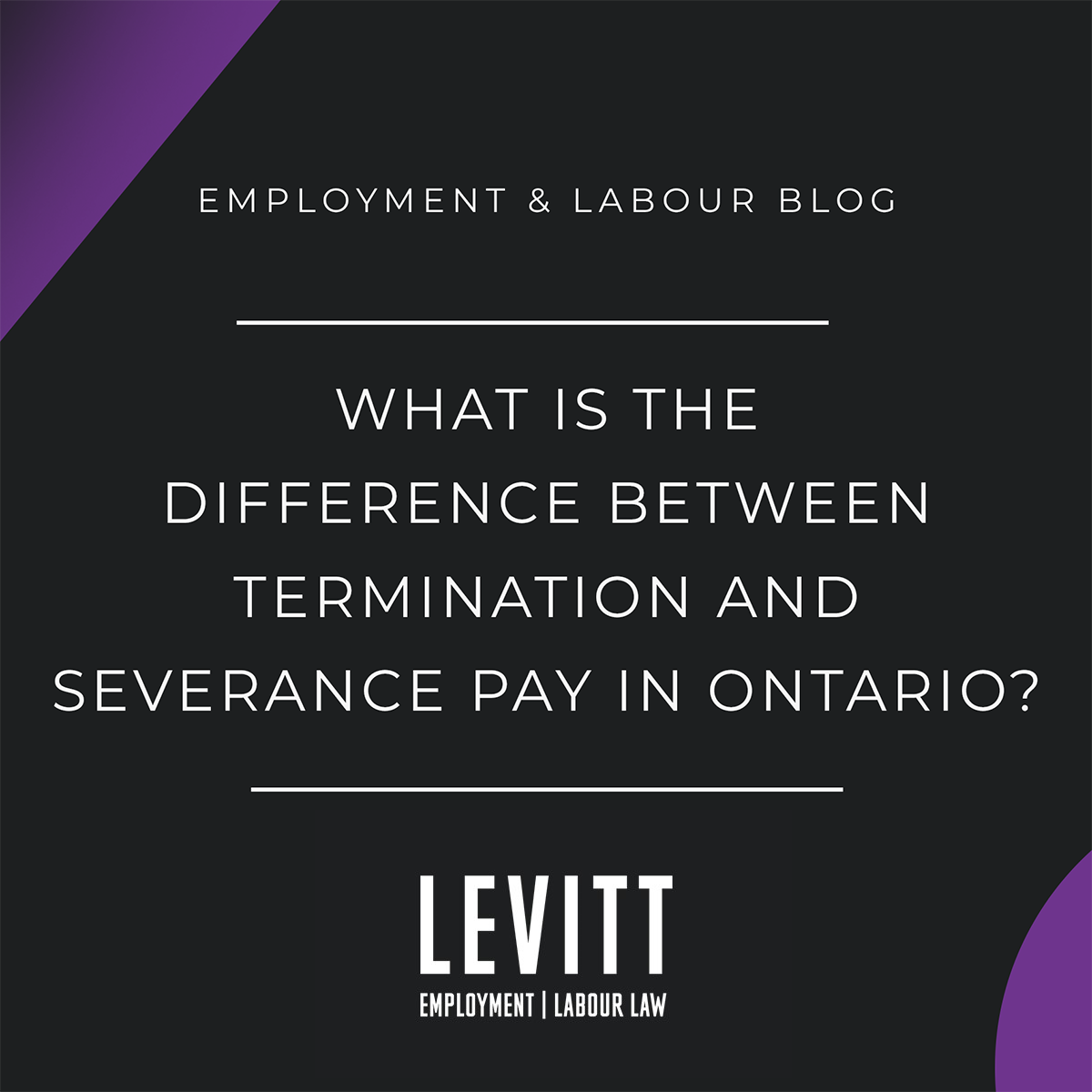
When an employee is terminated without cause, they are legally entitled to receive termination pay (or working notice of termination) and may be entitled to receive severance pay. Termination pay and severance pay are often conflated, so you may have heard others refer to them collectively as a “severance package”. However, termination pay and severance pay are distinct from one another. Although they often work hand in hand, they are two separate things.
Termination Pay
Termination pay is the lump sum payment given to an employee upon termination in lieu of providing the employee with reasonable notice of their termination. The termination pay must equal the amount the employee would have been entitled to receive had they been given proper notice. The minimum amount of termination pay an employee is entitled to is set out in the Employment Standards Act (“ESA”). However, employment contracts will usually stipulate how much notice an employee will be given, and accordingly, how much pay will be given in lieu of notice.
Under the ESA, an employee becomes eligible for termination pay, or notice of termination, after they have been continuously employed with their employer for three months or more. Importantly, the eligibility requirement is three months of continuous employment, not three months of active service. This means that periods of inactive employment – such as sick days, leave or lay-off – are included in the computation of time in which an employee is considered continuously employed.
The appropriate notice, or termination pay in lieu of notice, that you are entitled to under the ESA depends on the length of your employment. The following chart outlines the notice an employee is entitled to based on their length of service:
| Length of Service | Required Period of Notice |
| Less than 3 months | None |
| Less than 1 year | 1 week |
| 1 year but less than 3 years | 2 weeks |
| 3 years but less than 4 years | 3 weeks |
| 4 years but less than 5 years | 4 weeks |
| 5 years but less than 6 years | 5 weeks |
| 6 years but less than 7 years | 6 weeks |
| 7 years but less than 8 years | 7 weeks |
| 8 years or more | 8 weeks |
By way of example, if an employee has worked for a period of 5 years or more, but fewer than 6 years, the required period of notice would be a minimum of five weeks. If the employer chose to give said employee termination pay in lieu of notice, the employee would be entitled to receive a lump sum payment equivalent to the amount the employee would have received if they were given the 5 weeks notice of their termination.
It is important to note that an employer is required to provide termination pay to an employee on whichever of the following dates is later:
- seven days after the employee’s employment is terminated; or
- on the employee’s next regular pay date.
Most employers will seek to provide terminated employees with the minimum termination pay required under the ESA. However, if your employment contract purports to provide you with termination pay, or notice of termination, that falls short of your requirements under the ESA, then the contract becomes void, and you are entitled to termination pay governed by common law. You are also entitled to common law notice, or termination pay, if your employment contract is silent on the issue of termination of your employment. Common law reasonable notice includes your minimum entitlements under the ESA as well as additional notice or termination pay. Courts will consider several factors when deciding how much reasonable notice is sufficient for any specific employee.
To understand how much notice you are entitled to, and therefore how much termination pay you are legally owed, you should ensure to book a consultation with one of our lawyers.
Severance Pay
Under the ESA, severance pay is compensation paid to an employee whose employment has been severed by their employer. The ESA defines when severance of employment has occurred for the purpose of an employee’s entitlement to severance pay. As such, only the specific situations that are outlined in the ESA are considered to constitute the severing of an employment relationship, providing the terminated employee with entitlement to severance pay. The purpose of severance pay is to compensate long-term employees for losses upon termination of their employment.

The ESA sets only the minimum requirements for severance pay. The minimum severance pay set out in the ESA applies to employees who have worked with their employer for five years or more in Ontario and either:
- Were employed by a company who had a payroll of $2.5 million or more; or
- 50 or more employees had their employment severed within a 6-month period.
If the criteria mentioned above are met, the employee is owed 1 week of notice and/or severance pay for every year of service, up to a maximum total of 26 weeks.
The main difference between severance pay and termination pay is that severance pay is compensation that an employer must pay to a qualifying employee who has been terminated in addition to what is required under the ESA for notice of termination or termination pay.
Like termination pay, the term severance pay can also refer to common law notice of termination. Accordingly, you may be entitled to a larger severance payment than your employer offers you upon termination. Determining whether you have received a fair severance payment is a complex matter that requires the assistance of an employment lawyer.
You should get in touch with one of our experienced lawyers today to ensure you are getting the maximum amount you are entitled to upon termination. You can also learn more about severance pay here.
Conclusion
Although termination pay and severance pay are often thought of interchangeably, it is important to remember that they are two distinct entitlements with considerably different purposes. Termination pay is provided to qualified employees and is paid in lieu of notice of termination of their employment, whereas severance pay is owed to severed employees who meet the criteria set out in the ESA and is paid in addition to termination pay or required notice of termination.

